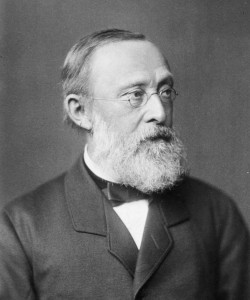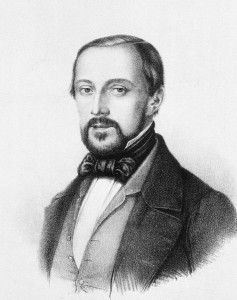 Rudolf Virchow was born in Prussia in October of 1821 to a working class family. He showed academic promise and excelled in school, eventually graduating from Friedrich-Wilhelms Institute (now known as Humbolt University of Berlin) with a degree in medicine. Rudolf’s chief goal was to help the German people stay healthy and he achieved this by studying pathology and debunking “humourism,” a harmful interpretation of what caused people to become sick. His first advancement, however, came from the facts he learned from his failure to contain the 1847-1848 typhus epidemic in Upper Silesia. This allowed his lay the foundation for public health initiatives in Germany and he disseminated his ideas through Die medicinische Reform a newspaper he founded about medical reform. In 1849 Rudolf became the first Chair of Pathological Anatomy at Berlin University. At this time he was also a part of Deutsche Fortschrittspartei, a political party Rudolf co founded, and through this group he was elected into the Prussian House of Representatives and won a seat in the Reichstag.
Rudolf Virchow was born in Prussia in October of 1821 to a working class family. He showed academic promise and excelled in school, eventually graduating from Friedrich-Wilhelms Institute (now known as Humbolt University of Berlin) with a degree in medicine. Rudolf’s chief goal was to help the German people stay healthy and he achieved this by studying pathology and debunking “humourism,” a harmful interpretation of what caused people to become sick. His first advancement, however, came from the facts he learned from his failure to contain the 1847-1848 typhus epidemic in Upper Silesia. This allowed his lay the foundation for public health initiatives in Germany and he disseminated his ideas through Die medicinische Reform a newspaper he founded about medical reform. In 1849 Rudolf became the first Chair of Pathological Anatomy at Berlin University. At this time he was also a part of Deutsche Fortschrittspartei, a political party Rudolf co founded, and through this group he was elected into the Prussian House of Representatives and won a seat in the Reichstag.
Next Rudolf moved on to oversee the Pathological Anatomy department at the University of Wurzburg in 1849. This, combined with his newpaper gained him acclaim in his field and he was invited back to Charite to direct it’s new Institute of Pathology. This campus is now named after him. Rudolf had strong opinions on politics and he had the prerogative to voice them, which caused some clashing within the Reichstag. His participation in the Revolution of 1848 led to his expulsion from Charite and Rudolf’s support of anti-catholic campaigns alienated some of his peers. He was a staunch enemy of evolutionary theories by Darwin, but at the same time conducted studies of school children’s hair and eye color and determined that the Aryan “race” concept was flawed.
Throughout his career, Rudolf published over two-thousand scientific works and his book Cellular Pathology (1858) is regarded as the foundation of modern pathology and is still referenced today. Rudolf was the first person in history to name and document various diseases such as leukemia, embolism, and thrombosis. He also was the first user of such terms as chromatin, agenesis, and spina bifida. Rudolf developed the first comprehensive guidelines for autopsy using surgery and microscopic examination of all body level cells. One of his most important discoveries, one which affected Berlin directly, was his discovery of the transmission cycle of roundworm common in Europe which established the practice of meat inspection. When Rudolf died in 1902 he was called the “Pope of medicine” by his colleagues due to his founding of social medicine and advancement of public health.
is regarded as the foundation of modern pathology and is still referenced today. Rudolf was the first person in history to name and document various diseases such as leukemia, embolism, and thrombosis. He also was the first user of such terms as chromatin, agenesis, and spina bifida. Rudolf developed the first comprehensive guidelines for autopsy using surgery and microscopic examination of all body level cells. One of his most important discoveries, one which affected Berlin directly, was his discovery of the transmission cycle of roundworm common in Europe which established the practice of meat inspection. When Rudolf died in 1902 he was called the “Pope of medicine” by his colleagues due to his founding of social medicine and advancement of public health.
Welcome to U.OSU.EDU! Comments are automatically turned on for all posts. Visit the following link to learn how to turn comments on/off: http://odee.osu.edu/resourcecenter/uosu/225